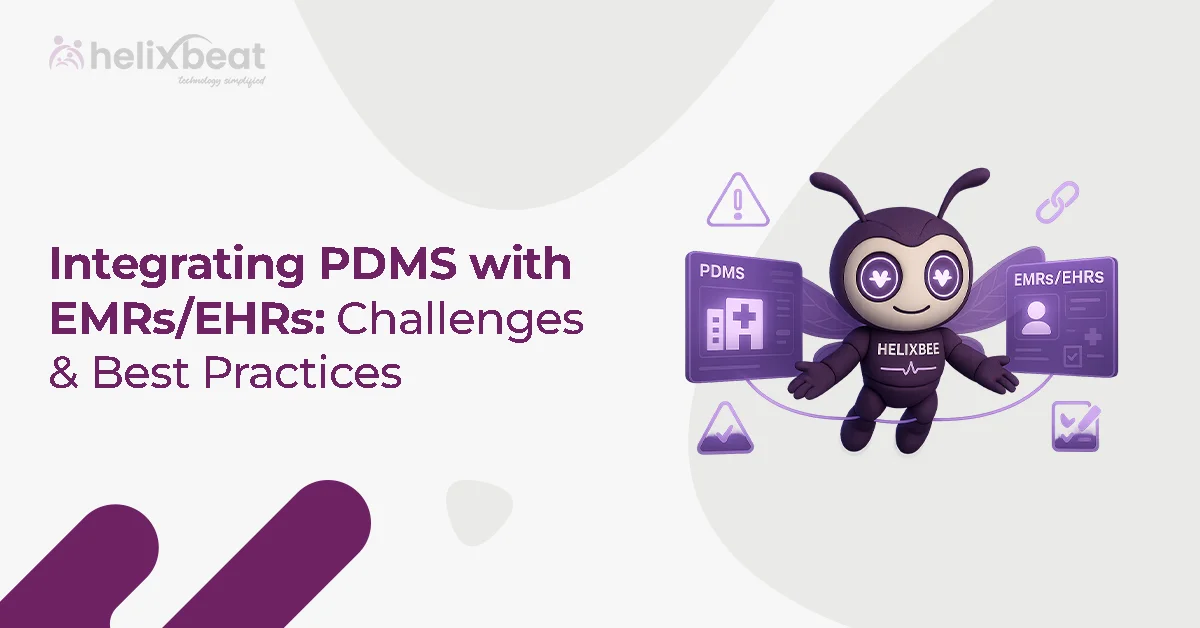The healthcare industry is expanding exceptionally, fueled by technological advances reshaping how we think about patient care. One such game-changer is PULSE, a powerful FHIR-based digital health platform that bridges the void between healthcare providers and patients, fostering seamless communication and engagement.
A study from HealthIT.gov reveals that 61% of healthcare providers have adopted at least one form of digital health technology in their practices. In this article, we’ll explore how embracing PULSE and other digital health solutions is helping providers expand their reach, effectively engage patients, and ultimately thrive in a competitive healthcare environment.

Table of Contents
What is Digital Health Technology?
Digital health technology refers to incorporating technology with healthcare services to enhance the quality, accessibility, and efficiency of care. It involves using digital tools, devices, and platforms to improve healthcare management, delivery, and consumption. Digital health contains various applications, from wearables tracking personal health data to telemedicine solutions enabling remote consultations.
Key Innovations in Digital Health Technology:
- Wearable Devices
- Wearables are one of the most popular innovations in digital health.
- These devices, such as smartwatches and fitness trackers, monitor vital health metrics, including heart rate, steps taken, calories burned, sleep patterns, and blood oxygen levels.
- Advanced wearables can also track more complex data, such as ECG (electrocardiograms) and blood pressure.
- These devices help individuals manage their health proactively and can provide real-time data that doctors use to adjust treatment plans.
- Telemedicine
- Telemedicine allows healthcare providers to consult with patients remotely, using video calls, phone consultations, or online messaging.
- This has dramatically expanded access to healthcare, particularly in rural or underserved areas, where patients may have difficulty accessing traditional in-person care.
- Through telemedicine platforms, patients can receive advice, prescriptions, and follow-up care, reducing the need for physical visits and saving time and resources for both patients and healthcare providers.
- Electronic Health Records (EHR)
- Electronic Health Records (EHR) are digital versions of patients’ paper charts.
- They contain a patient’s complete medical history, including diagnoses, medications, treatment plans, and test results.
- EHRs allow healthcare providers to share information quickly and securely, leading to better-coordinated care.
- They also help reduce errors, streamline workflows, and improve patient outcomes by providing real-time access to accurate, up-to-date patient data.
Benefits of Digital Health Technology for Patient Acquisition
Digital health technology is revolutionizing healthcare by offering a range of benefits that directly impact providers and patients. At Helixbeat, leveraging advanced digital health solutions enables healthcare organizations to unlock new efficiency, safety, and cost-effectiveness levels.
- Enhances Patient Care and Safety
- One of the most critical advantages of digital health technology is the significant improvement in patient care quality and safety.
- By using digital records and real-time data updates, healthcare providers reduce the chances of human error, such as misreading handwritten notes or missing vital patient information.
- Electronic Health Records (EHRs) integrated with Helixbeat’s platform provide instant access to patient history, allergies, medications, and test results, enabling informed clinical decisions.
- This seamless data flow supports timely interventions, minimizes medical errors, and promotes personalized care plans tailored to individual patient needs.
- Improves Operational Efficiency
- Digital health technology streamlines administrative and clinical workflows, saving time and resources.
- Helixbeat’s solutions automate routine tasks such as appointment scheduling, billing, and data entry, reducing paperwork and freeing staff to focus on direct patient care.
- Faster data processing means clinicians receive up-to-date patient information without delays, improving department communication.
- This efficiency accelerates patient throughput, enhances coordination among care teams, and optimizes resource utilization, ultimately leading to a smoother healthcare delivery experience.
- Reduces Costs Through Automation and Predictive Analytics
- Implementing Helixbeat’s digital health technology translates into substantial cost savings for healthcare providers.
- Automation lowers the need for manual labour, cutting administrative overhead and minimizing errors that could lead to costly corrective treatments.
- Furthermore, AI-powered predictive analytics enables early identification of high-risk patients and potential health issues, allowing preventive care that reduces hospital admissions and expensive interventions.
- Digital health technology supports sustainable financial management while maintaining high care standards by optimizing resource allocation and reducing unnecessary tests or procedures.
Digital Health Technology for Patient Acquisition
Attracting and retaining patients is increasingly important. Digital health technology is key in how healthcare providers engage with new and existing patients. By using these tools, organizations can improve patient acquisition, enhance experiences, and build long-term loyalty.
Digital health technologies offer multiple channels and platforms to engage patients before, during, and after their healthcare visits. Some of the most impactful tools have:
- Online Appointment Scheduling
Allowing patients to book appointments 24/7 via websites or mobile apps removes barriers, enhances convenience, and increases patient inflow.
- Patient Portals
Secure online platforms where patients can access their medical records and test results and communicate with providers to encourage active participation and improve satisfaction.
- Telemedicine Services
Virtual consultations expand a provider’s reach beyond geographical limits, enabling access to patients who prefer or require remote care.
- Digital Marketing and Outreach
Targeted social media campaigns, search engine optimization (SEO), and email marketing help providers attract new patients by increasing visibility and credibility.
- Automated Reminders and Follow-ups
SMS and email notifications for appointment reminders, prescription refills, or preventive care prompt timely engagement and reduce no-shows.
- Personalized Patient Communication
AI-powered chatbots and CRM systems deliver tailored health information and service recommendations, creating a more customized patient experience.
CTA: Discover How Helixbeat Can Transform Your Patient Acquisition Strategy
Role of Digital Health Acquisitions
Digital health acquisitions have evolved a strong approach to accelerate development, innovation, and improved care delivery across the healthcare industry. Here’s how they make an impact:
- Fuel Innovation and Technology Integration
Acquisitions enable healthcare organizations to quickly adopt cutting-edge digital health technologies such as telemedicine platforms, AI-driven diagnostics, and patient engagement tools without building them from scratch. This accelerates innovation and expands the technological capabilities of acquiring companies.
- Expand Patient Access and Engagement
Healthcare providers can broaden their service offerings by acquiring specialized digital health companies. For instance, integrating telehealth solutions helps reach patients in remote areas and enhances convenience, increasing patient acquisition and engagement rates. Studies show that patient engagement can improve by up to 30% post-acquisition of digital health solutions.
- Enhance Care Delivery and Outcomes
Digital health acquisitions allow organizations to incorporate advanced data analytics, remote monitoring, and personalized care models. These improvements lead to better clinical outcomes and more efficient care pathways, benefiting providers and patients.
- Drive Market Competitiveness and Revenue Growth
As the digital health sector rapidly evolves, acquiring companies gain a competitive edge by offering innovative services and attracting tech-savvy patients. This can translate into significant revenue growth and stronger market positioning.
- Facilitate Compliance and Interoperability
Acquisitions often include access to platforms that support interoperability standards like FHIR, improving data exchange and regulatory compliance. This reduces operational complexity and improves patient safety.
What Is the Future of Digital Healthcare?
87% of health organizations report improvements in patient satisfaction after using digital health tools.
- AI and Machine Learning
Artificial intelligence (AI) and machine learning are poised to revolutionize healthcare by enabling predictive analytics and personalized medicine. AI & ML algorithms analyze patient data to forecast disease progression, recommend tailored treatments, and identify at-risk patients before symptoms manifest. This capability leads to:
- More accurate diagnoses.
- Optimized treatment plans.
- Enhanced preventive care.
- Reduced hospital readmissions.
- Blockchain: Securing Data and Ensuring Interoperability
Blockchain technology offers a decentralized and tamper-proof way to securely store and share patient information. Its application in digital health includes:
- Protecting patient privacy by encrypting health records.
- Enabling secure and seamless data sharing across different healthcare systems.
- Enhancing trust and transparency between patients and providers.
- Supporting interoperability by standardizing data exchange protocols.
- Blockchain’s immutable ledger helps reduce fraud, prevent data breaches, and gives patients greater control over their health data.
Closing Thoughts
Struggle with fragmented patient engagement, inefficient acquisition processes, and outdated systems that slow care delivery and growth. These challenges can lead to lower patient satisfaction, missed opportunities for expansion, and increased operational costs. This is where Helixbeat’s digital health technology steps in as a game-changer.
Embracing Helixbeat’s solutions allows your practice to thrive in this new era of healthcare, delivering better care while expanding your reach.
Ready to solve your healthcare challenges and transform your practice? Click to get in touch.
FAQs
- What is digital health technology?
Digital health technology refers to the use of digital tools and platforms like telemedicine, mobile health apps, wearable devices, and electronic health records to improve healthcare delivery, patient outcomes, and system efficiency.
- How can digital health technology improve patient acquisition?
It enhances patient acquisition by offering convenient services such as online appointment booking, virtual consultations, and personalized communication, which attract and retain patients more effectively.
- What are the benefits of digital health technology in healthcare?
Benefits include improved patient engagement, faster access to care, enhanced data accuracy, reduced costs, better care coordination, and increased operational efficiency.
- What trends are shaping the future of digital healthcare?
Key trends include AI and machine learning for predictive care, blockchain for secure data exchange, telemedicine expansion, wearable health monitoring, and advanced data analytics driving personalized medicine.
- What is the future of digital healthcare?
Digital healthcare will evolve with AI, predictive analytics, and personalized patient care.
- How could technology be used to improve patient engagement in their health?
By providing real-time data, reminders, and empowering patients with information via mobile apps and wearables














